Sounds of Spring, Frog Style
Have you heard them yet? Choruses of happy frogs and toads are celebrating spring by broadcasting their mating calls. Frog and toad reproduction is a noisy affair. Males of each species produce a unique mating call. Male frogs have one or two vocal sacs (depending on the species) and calls are produced by forcing air over vocal fold, back and forth between the vocal sacs and the lungs.
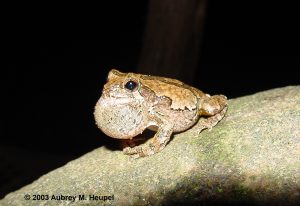
The Illinois Natural History Survey has a fun website where you can hear frog calls and find out how to mimic them (https://www.inhs.illinois.edu/outreach/spotlight/na/mimic-frog-call/ ). Illinois is home to 21 species of frogs & toads. You might be surprised to learn that more than 70% of these amphibian types (15 species) can be found locally, in a few mile-wide swath of land on either side of the bluffs that stretch from Dupo in the north to Prairie Du Rocher in the south. The key to such rich diversity is the multitude of habitats included in the “bluff corridor”. The bluffs themselves provide a myriad of hidey-holes and slabs of loose rock for amphibians to shelter.
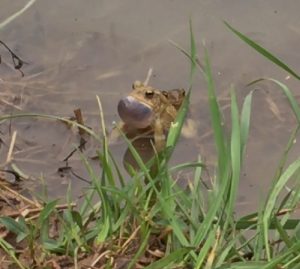
Capping the bluffs are hill prairies and woodland ecosystems that provide abundant invertebrates, which are food for hungry amphibians. And then there is the water! The term amphibian is derived from two Greek terms, amphi (meaning ‘both’) and bios (meaning ‘life’), a reference to the fact that most species in the group have a larval stage in the water and adults that live on land. If you head east away from the bluffs you quickly encounter a karst terrain peppered with circular sinkhole ponds. Perfect breeding habitat for many frogs and toads. Flowing under the sinkhole plain are cave streams that provide cool refuge in the summer and overwintering sites for some species. To the west, the floodplain of the Mississippi River terminates at the base of the bluffs. Marshes and temporary wetlands of the floodplain are some of the best places in the area to find amphibians.
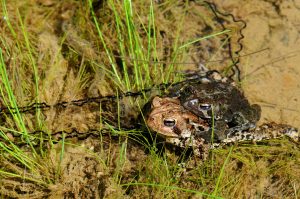
Many frog and toad species are “explosive breeders” with nearly all individuals breeding in a narrow time frame, triggered by warming spring temperatures and rainfall. Spring Peepers, Chorus Frogs, Leopard Frogs, and American Toads are all deep into their breeding season now. Cricket Frogs, Fowler’s Toads, Grey Treefrogs and others are soon to follow.
The Eastern Spadefoot is a curious species that will breed in spring or summer, but only after torrential rains. Loud choruses of calling males form at breeding sites. Females from surrounding areas are attracted to the chorus and can even make their choice of which male to seek based on his call within the chorus. Eggs are fertilized externally and embryos hatch into the aquatic larval stage commonly called a tadpole or pollywog. Tadpoles are herbivores. They use rows of hard ridges on their lips to scrape algae and submerged plant material into their mouth. As rough as puberty seems to a human teenager, imagine the changes the tadpole undergoes in its metamorphosis to a frog. Sprouting arms and legs, supported by brand new nerves, muscles and bones is impressive. But, the really amazing changes are happening in the tadpole’s digestive system. The entire intestinal system transitions from a very long coiled tube adapted to digesting plants, to a shortened carnivore system since adult frogs and toads eat insects and other invertebrate animals. The entire metamorphosis plays out in a matter of weeks in some species or months in others.
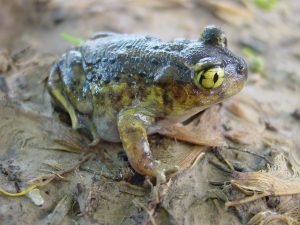
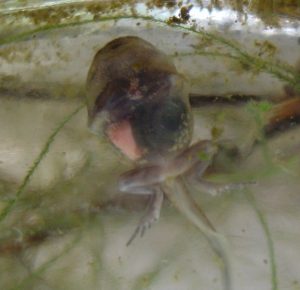
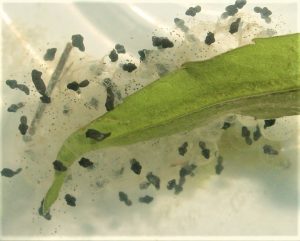
Approximately 88% of all amphibian species on Earth are some type of frog or toad. Frogs have an impressive suite of adaptations that make them so successful. Powerful hind limbs allow frogs to travel relatively long distances while feeding and searching for breeding sites. Modifications to toes and feet allow some to climb trees, some to burrow in the dirt, and allow others to be efficient swimmers. In spite of their many excellent adaptations, more than 1/3 of all amphibian species on Earth are in danger of extinction. The reasons for amphibian declines are many, and include habitat loss, pollution and the spread of pathogenic skin fungi. If you are lucky enough to own or manage property that supports populations of frogs and salamanders, consider amphibian-friendly management choices (see http://www.clifftopalliance.org/amphibians-in-sinkhole-ponds-best-management-practices/ for examples).
CLIFFTOP, a local nonprofit organization, is focused on preserving and protecting area bluff lands.
A version of this article appeared in the April 17, 2020 edition of the Monroe County Independent.
©2020 all content rights reserved Clifftop NFP.
Comments are currently closed.
